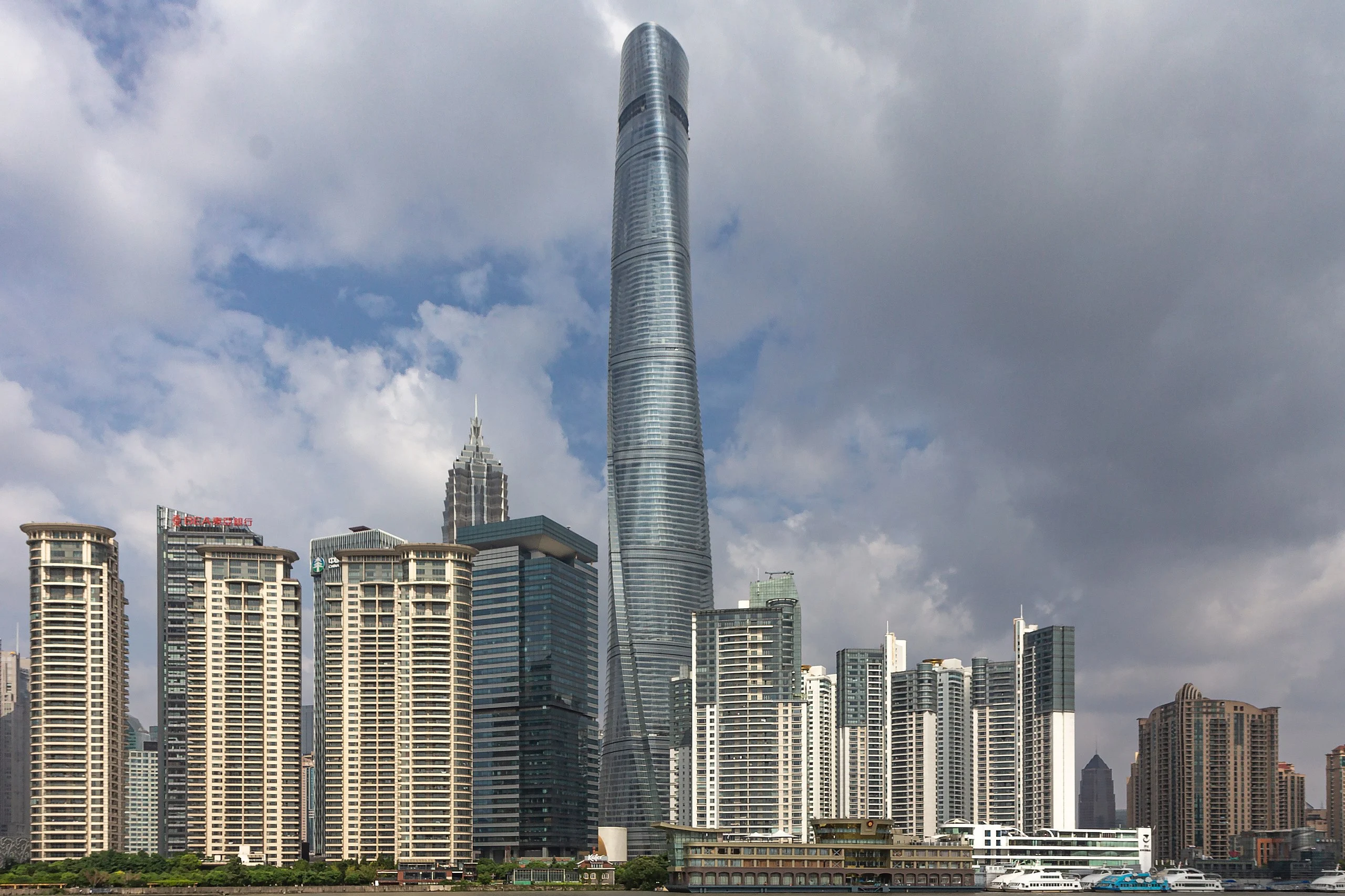
The Shanghai Tower, an architectural marvel and a symbol of modern urban development, stands as the second tallest building in the world. With its striking design and impressive height of 632 meters (2,073 feet), it has become an iconic feature of Shanghai’s skyline. Completed in 2015, the tower is not only a testament to engineering excellence but also serves as a mixed-use space, housing offices, a luxury hotel, and retail areas. Its remarkable design incorporates advanced seismic safety features, making it resilient against earthquakes. As a popular tourist destination, the observation deck attracts millions of visitors each year, offering breathtaking views of the bustling city below.
Height: The Shanghai Tower reaches an impressive height of 632 meters (2,073 feet), making it not only the tallest building in China but also the second tallest in the world, surpassed only by the Burj Khalifa in Dubai. This remarkable height contributes to its iconic status in the Shanghai skyline and serves as a symbol of China’s rapid urban development and architectural ambition. The tower’s height is significant as it allows for breathtaking views of the city and beyond, attracting tourists and locals alike to its observation deck.
Floors: The Shanghai Tower comprises 128 floors above ground and 5 basement levels, making it one of the tallest multi-story buildings globally. This extensive number of floors accommodates various functions, including office spaces, a luxury hotel, and retail areas. The design of the tower allows for efficient vertical circulation and maximizes the use of space, ensuring that each level offers stunning views of the surrounding urban landscape.
Construction Start: Construction of the Shanghai Tower commenced on November 29, 2008. This marked the beginning of a significant architectural project that would take several years to complete. The construction process involved meticulous planning and engineering to ensure that the building could withstand the environmental challenges posed by its height, including strong winds and seismic activity. The project was a key part of Shanghai’s ambition to position itself as a global financial hub.
Completion Date: The Shanghai Tower was officially completed in 2015, with the grand opening taking place on September 1, 2016. The completion of the tower was celebrated as a major achievement in modern architecture and engineering. It represented not just the culmination of years of hard work and investment but also the city’s commitment to innovative design and sustainable practices. The opening attracted significant media attention and marked a new era for Shanghai as a leading global city.
Architect: The architectural firm Gensler, led by architect Jun Xia, designed the Shanghai Tower. Gensler is renowned for its innovative approach to architecture, and the Shanghai Tower exemplifies this philosophy with its unique twisting design. This design not only enhances the building’s aesthetic appeal but also serves practical purposes, such as reducing wind loads and improving energy efficiency. Jun Xia’s vision for the tower was to create a structure that harmonizes with the urban environment while pushing the boundaries of architectural possibilities.
Structural System: The Shanghai Tower features a unique twisting shape that is designed to reduce wind loads on the building. This innovative structural system allows the tower to withstand the strong winds that often affect tall buildings in urban environments. The twisting form also contributes to the building’s overall stability, making it safer for occupants. The architectural design incorporates a central core that houses elevators and emergency stairwells, providing structural integrity while maximizing usable floor space.
Total Floor Area: The total floor area of the Shanghai Tower is approximately 380,000 square meters (4,090,000 square feet). This vast area is utilized for a variety of purposes, including office spaces, a hotel, and retail establishments. The extensive floor area allows for a diverse range of activities within the building, making it a vibrant hub of commerce and tourism. The design optimizes the use of space, ensuring that each area is functional and accessible.
Elevator Speed: The Shanghai Tower is home to the world’s fastest elevator, which can reach speeds of 20.5 meters per second (45.8 miles per hour). This remarkable speed significantly reduces wait times and enhances the overall experience for visitors and occupants. The elevator system is equipped with advanced technology that ensures safety and efficiency, allowing for smooth and rapid transport between the building’s many floors, including the observation deck located high above.
Observation Deck: The observation deck of the Shanghai Tower is situated on the 118th floor, at a height of 546 meters (1,791 feet). This deck offers unparalleled panoramic views of Shanghai and its surroundings, making it a popular attraction for tourists and locals. Visitors can enjoy breathtaking vistas of the city’s skyline, the Huangpu River, and beyond. The observation deck is designed with safety and comfort in mind, providing visitors with an unforgettable experience as they take in the sights from one of the highest points in the world.
Wind Turbines: The Shanghai Tower is equipped with wind turbines that generate renewable energy, reflecting its commitment to sustainable design. These turbines harness wind energy to help power the building, contributing to its overall energy efficiency. This feature aligns with global trends toward sustainability in architecture, showcasing how modern skyscrapers can incorporate renewable energy sources. The use of wind turbines is part of a broader strategy to reduce the building’s carbon footprint and promote environmentally friendly practices in urban development.
Green Building: The Shanghai Tower is recognized for its sustainable design and has received a LEED Platinum certification, the highest rating awarded by the U.S. Green Building Council. This certification reflects the building’s commitment to energy efficiency, water conservation, and indoor environmental quality. The design incorporates numerous eco-friendly features, including rainwater harvesting systems, energy-efficient lighting, and high-performance insulation. By prioritizing sustainability, the Shanghai Tower sets a benchmark for future skyscrapers and contributes to the growing trend of green architecture in urban environments.
Foundation: The foundation of the Shanghai Tower is a remarkable 3.7 meters (12 feet) thick and consists of 200 piles driven deep into the ground. This robust foundation is essential for supporting the immense weight of the tower and ensuring its stability against environmental forces such as wind and earthquakes. The construction of such a deep foundation required extensive geological surveys and engineering calculations to ensure that it could safely support the building’s height and design. This engineering feat is critical to the tower’s long-term durability and safety.
Cost: The total construction cost of the Shanghai Tower was approximately $2.4 billion, making it one of the most expensive building projects in the world. This significant investment reflects the advanced technology, materials, and labor involved in creating such a complex structure. The funding for the project came from a combination of public and private sources, highlighting the importance of the tower as a key component of Shanghai’s economic development strategy. The high cost also underscores the ambition behind the project, aiming to create a landmark that symbolizes modern China.
Concrete Volume: The construction of the Shanghai Tower utilized about 450,000 cubic meters (590,000 cubic yards) of concrete. This substantial amount of concrete was necessary to create the tower’s robust structure, including its core and floors. The use of high-strength concrete not only provides the building with the required durability but also contributes to its overall energy efficiency. The volume of concrete used is indicative of the scale of the project and the engineering challenges faced during construction, particularly in achieving the desired height and stability.
Steel Weight: The total weight of the structural steel used in the Shanghai Tower is around 100,000 tons. This steel framework is crucial for providing the necessary strength and stability to support the building’s height and withstand environmental forces. The use of advanced steel materials allows for a lighter structure while maintaining safety and performance standards. The weight of the steel also plays a significant role in the building’s overall design, influencing factors such as wind resistance and seismic performance.
Sky Garden: The Shanghai Tower features nine sky gardens located at various heights throughout the building. These green spaces provide not only aesthetic value but also serve functional purposes, such as improving air quality and offering recreational areas for occupants. The sky gardens are designed to be accessible and promote a sense of community within the tower, allowing people to gather and enjoy nature amidst the urban environment. This integration of greenery into a high-rise structure reflects a growing trend in architecture to create more livable and sustainable urban spaces.
Fire Safety: The Shanghai Tower includes advanced fire safety systems designed to protect occupants in the event of an emergency. This includes multiple evacuation routes, pressurized stairwells, and state-of-the-art fire detection and suppression systems. The design prioritizes the safety of those inside the building, ensuring that they can evacuate quickly and efficiently. Regular safety drills and maintenance of these systems are essential to ensure that the building remains safe for all its occupants, reflecting the importance of fire safety in modern skyscraper design.
Lighting: The exterior of the Shanghai Tower is illuminated by LED lights, which can display a variety of colors and patterns. This dynamic lighting system enhances the building’s architectural features and contributes to the nighttime skyline of Shanghai. The use of LED technology is not only energy-efficient but also allows for creative expression through light displays, making the tower a visual landmark after dark. The lighting design plays a significant role in promoting the tower as a tourist attraction and a symbol of modernity in the city.
Cultural Significance: The design of the Shanghai Tower is inspired by traditional Chinese art and culture, particularly the concept of a spiral, which symbolizes growth and prosperity. This cultural reference adds depth to the building’s architectural narrative, connecting it to China’s rich history while representing its future aspirations. The tower’s twisting form is intended to evoke the image of a dragon, a symbol of power and strength in Chinese culture. This thoughtful integration of cultural elements into the design helps the tower resonate with both local and international audiences.
Visitor Statistics: The observation deck of the Shanghai Tower is a major attraction, drawing millions of visitors each year who come to experience breathtaking views of the city from one of the highest points in the world. Located on the 118th floor, the deck offers a unique perspective of Shanghai’s sprawling urban landscape, the Huangpu River, and the bustling Lujiazui financial district. The popularity of the observation deck contributes significantly to the tower’s status as a landmark, making it a must-visit destination for tourists and locals alike. The high volume of visitors also highlights the cultural and economic importance of the Shanghai Tower as a symbol of modern architecture and urban development.
Construction Workforce: During its construction, which began in 2009 and concluded in 2015, the Shanghai Tower employed a peak workforce of approximately 1,000 workers. This large team was essential to the project’s ambitious scale and complexity, as the tower stands at a staggering height of 632 meters (2,073 feet). The construction process involved advanced engineering techniques and innovative materials to ensure the building’s structural integrity and safety. The workforce included skilled laborers, engineers, and project managers who collaborated to overcome challenges associated with constructing one of the tallest buildings in the world, showcasing the dedication and expertise required to complete such an iconic structure.
Global Ranking: As of October 2023, the Shanghai Tower holds the title of the second tallest building in the world, standing at 632 meters (2,073 feet), just behind the Burj Khalifa in Dubai, which reaches 828 meters (2,717 feet). This impressive ranking reflects not only the architectural achievement of the Shanghai Tower but also China’s rapid urbanization and economic growth. The building’s height is a testament to the advancements in engineering and design, featuring a twisting form that reduces wind loads and enhances stability. The tower’s prominence in the global skyline has made it an iconic representation of modernity and innovation in architecture.
Seismic Design: The Shanghai Tower is engineered to withstand earthquakes of up to magnitude 9.0, making it one of the most seismically resilient buildings in the world. This design consideration is particularly important given Shanghai’s location in a region that can experience seismic activity. The tower’s structure incorporates a reinforced concrete core and a unique spiraling shape, which helps to distribute stress and reduce the impact of seismic forces. The building’s safety features ensure that it can protect occupants during an earthquake, reflecting the commitment to safety and resilience in modern architecture.
Mixed-Use: The Shanghai Tower is a mixed-use development that combines office space, hotel accommodations, and retail areas within its 128 floors. This multifunctional approach not only maximizes the use of space but also creates a vibrant environment where business, leisure, and commerce intersect. The tower houses the world’s highest hotel, the J Hotel, located on the top floors, offering luxurious accommodations and stunning views. Additionally, the presence of offices for multinational corporations and retail outlets enhances the tower’s role as a hub of economic activity, making it a focal point for both local and international visitors.
Iconic Status: The Shanghai Tower is an integral part of the Lujiazui skyline, which features other notable skyscrapers like the Jin Mao Tower and the Shanghai World Financial Center. This cluster of architectural marvels has become synonymous with Shanghai’s identity as a global financial center and a symbol of modernity. The tower’s distinctive twisting design and height contribute to its iconic status, making it a recognizable landmark both in the city and around the world. As part of the skyline, the Shanghai Tower not only represents architectural innovation but also serves as a testament to Shanghai’s rapid growth and development in the 21st century.
Frequently Asked Questions About Shanghai Tower
General Questions
1. What is Shanghai Tower?
- Shanghai Tower is a 632-meter (2,073 feet) tall skyscraper located in the Lujiazui area of Pudong district, Shanghai, China. It is the tallest building in China and the second-tallest building in the world.
2. When was Shanghai Tower completed?
- Construction of Shanghai Tower was completed in 2015.
3. Who designed Shanghai Tower?
- Shanghai Tower was designed by the American architectural firm Gensler.
Architecture and Design
4. What is the unique design of Shanghai Tower?
- Shanghai Tower is known for its distinctive twisted shape, which helps to reduce wind loads on the building. The tower also features a series of sky gardens and public spaces, providing visitors with stunning views of the city.
5. How many floors does Shanghai Tower have?
- Shanghai Tower has 128 floors.
Visitor Experience
6. Can tourists visit Shanghai Tower?
- Yes, tourists can visit Shanghai Tower. There are observation decks and other attractions open to the public.
7. What are the attractions at Shanghai Tower?
- Some of the attractions at Shanghai Tower include:
- Observation decks with panoramic views of Shanghai
- Restaurants and cafes
- Retail shops
- A museum dedicated to the history and construction of the tower
8. How much does it cost to visit Shanghai Tower?
- Ticket prices for Shanghai Tower can vary depending on the time of year and the specific attractions you want to visit. It’s best to check the official website or purchase tickets in advance for the most up-to-date information.
Sustainability
9. Is Shanghai Tower an environmentally friendly building?
- Yes, Shanghai Tower is designed to be environmentally friendly. It incorporates various sustainable features, such as energy-efficient lighting and HVAC systems, as well as rainwater harvesting.
10. What are some of the sustainable features of Shanghai Tower?
- Some of the sustainable features of Shanghai Tower include:
- Energy-efficient lighting and HVAC systems
- Rainwater harvesting
- Solar panels
- Green roofs









